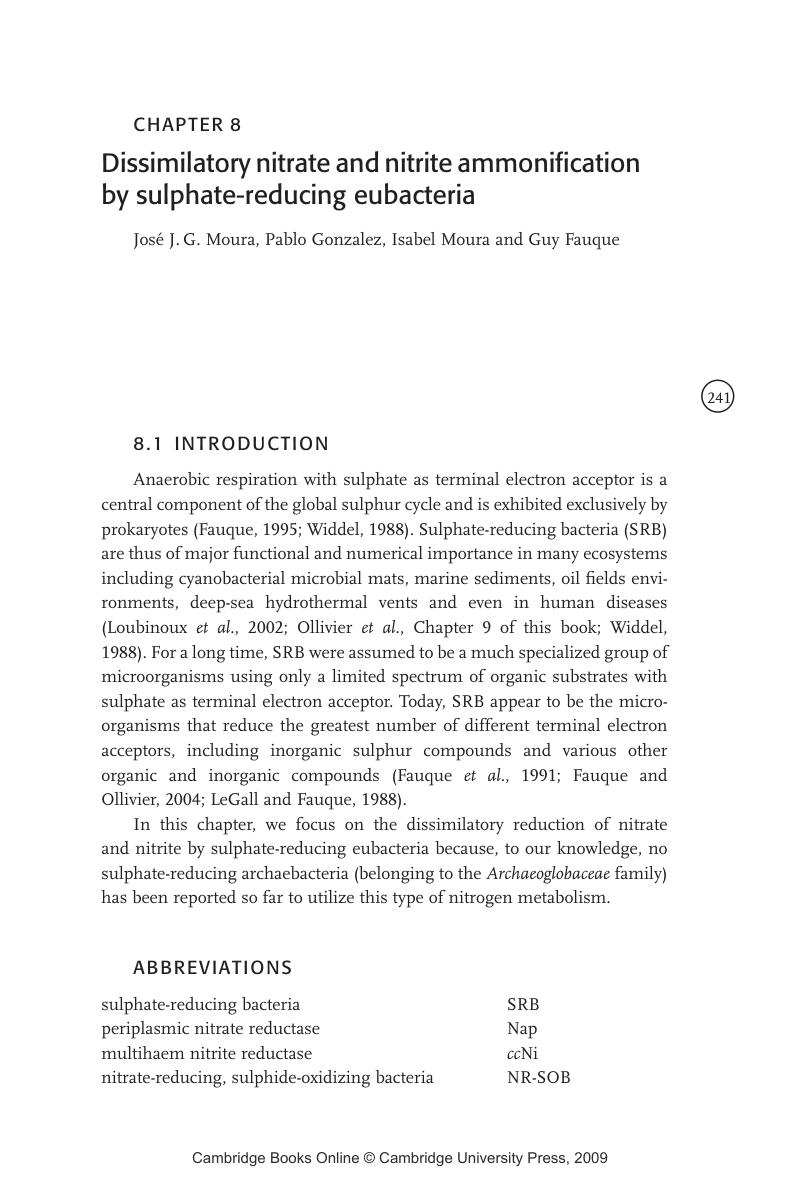Book contents
- Frontmatter
- Contents
- List of Contributors
- Preface
- 1 Energy metabolism and phylogenetic diversity of sulphate-reducing bacteria
- 2 Molecular strategies for studies of natural populations of sulphate-reducing microorganisms
- 3 Functional genomics of sulphate-reducing prokaryotes
- 4 Evaluation of stress response in sulphate-reducing bacteria through genome analysis
- 5 Response of sulphate-reducing bacteria to oxygen
- 6 Biochemical, proteomic and genetic characterization of oxygen survival mechanisms in sulphate-reducing bacteria of the genus Desulfovibrio
- 7 Biochemical, genetic and genomic characterization of anaerobic electron transport pathways in sulphate-reducing Delta proteobacteria
- 8 Dissimilatory nitrate and nitrite ammonification by sulphate-reducing eubacteria
- 9 Anaerobic degradation of hydrocarbons with sulphate as electron acceptor
- 10 Sulphate-reducing bacteria from oil field environments and deep-sea hydrothermal vents
- 11 The sub-seafloor biosphere and sulphate-reducing prokaryotes: their presence and significance
- 12 Ecophysiology of sulphate-reducing bacteria in environmental biofilms
- 13 Bioprocess engineering of sulphate reduction for environmental technology
- 14 Bioremediation of metals and metalloids by precipitation and cellular binding
- 15 Enzymatic and genomic studies on the reduction of mercury and selected metallic oxyanions by sulphate-reducing bacteria
- 16 Sulphate-reducing bacteria and their role in corrosion of ferrous materials
- 17 Anaerobic metabolism of nitroaromatic compounds and bioremediation of explosives by sulphate-reducing bacteria
- 18 Sulphate-reducing bacteria and the human large intestine
- Index
- Plate section
- References
8 - Dissimilatory nitrate and nitrite ammonification by sulphate-reducing eubacteria
Published online by Cambridge University Press: 22 August 2009
- Frontmatter
- Contents
- List of Contributors
- Preface
- 1 Energy metabolism and phylogenetic diversity of sulphate-reducing bacteria
- 2 Molecular strategies for studies of natural populations of sulphate-reducing microorganisms
- 3 Functional genomics of sulphate-reducing prokaryotes
- 4 Evaluation of stress response in sulphate-reducing bacteria through genome analysis
- 5 Response of sulphate-reducing bacteria to oxygen
- 6 Biochemical, proteomic and genetic characterization of oxygen survival mechanisms in sulphate-reducing bacteria of the genus Desulfovibrio
- 7 Biochemical, genetic and genomic characterization of anaerobic electron transport pathways in sulphate-reducing Delta proteobacteria
- 8 Dissimilatory nitrate and nitrite ammonification by sulphate-reducing eubacteria
- 9 Anaerobic degradation of hydrocarbons with sulphate as electron acceptor
- 10 Sulphate-reducing bacteria from oil field environments and deep-sea hydrothermal vents
- 11 The sub-seafloor biosphere and sulphate-reducing prokaryotes: their presence and significance
- 12 Ecophysiology of sulphate-reducing bacteria in environmental biofilms
- 13 Bioprocess engineering of sulphate reduction for environmental technology
- 14 Bioremediation of metals and metalloids by precipitation and cellular binding
- 15 Enzymatic and genomic studies on the reduction of mercury and selected metallic oxyanions by sulphate-reducing bacteria
- 16 Sulphate-reducing bacteria and their role in corrosion of ferrous materials
- 17 Anaerobic metabolism of nitroaromatic compounds and bioremediation of explosives by sulphate-reducing bacteria
- 18 Sulphate-reducing bacteria and the human large intestine
- Index
- Plate section
- References
Summary

- Type
- Chapter
- Information
- Sulphate-Reducing BacteriaEnvironmental and Engineered Systems, pp. 241 - 264Publisher: Cambridge University PressPrint publication year: 2007
References
- 14
- Cited by



